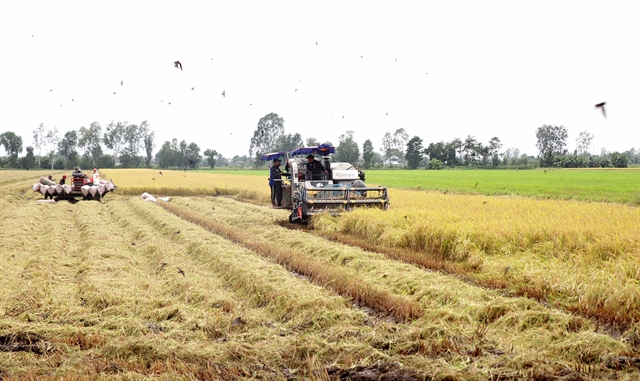 Society
Society

Improving profits for rice growers is always a concern of the Ministry of Agriculture and Rural Development (MARD), as well as the rice processing and trading business community.

|
| Harvesting rice in the Mekong Delta. — VNA/VNS Photo Thu Hiền |
MEKONG DELTA REGION — Rice farmers in the Mekong Delta are currently facing many major problems related to production and climate change.
When rice no longer provides the profits that farmers want, many ineffective rice production areas are converted to other crops with higher economic efficiency.
In addition, as climate change and saltwater intrusion become more complicated, rice is increasingly threatened as this is a crop that depends on water sources.
Therefore, improving profits for rice growers is always a concern of the Ministry of Agriculture and Rural Development (MARD) as well as the rice processing and trading business community.
According to MARD statistics, the country has more than 7 million hectares of rice production in all three seasons, of which, the Cửu Long (Mekong Delta) region accounts for more than 3.8 million hectares, equivalent to more than 53 per cent of the country's total rice production area.
However, the region is also an area greatly affected by climate change, especially the influence of salinity intrusion, which has a strong impact on rice growing areas.
If climate change and saltwater intrusion become severe, many rice areas will be completely lost.
According to Lê Đức Thịnh, director of the Department of Economic Co-operation and Rural Development, currently Việt Nam’s agricultural industry is oriented towards modern, multi-value, ecological and transparent development.
However, the agricultural labour force is gradually withdrawing from rural areas, switching to many other occupations.
Therefore, there are fewer rice workers and the cultivation area is shrinking, forcing the rice industry to change direction.
To maintain its current position as a food supplier for the whole country and exports, rice farmers must increase the application of scientific and technological advances in production, reduce production and labour costs and create high value.
In addition, rice processing and exporting businesses also believe that in addition to applying science and technology to rice production, increasing productivity is also a key factor.
Nguyễn Quang Hòa, director of Dương Vũ Ltd., said that currently, the MARD also had a project to develop one million hectares of high-quality, low-emission rice associated with green growth by 2030.
However, it was necessary to focus on choosing rice varieties that could increase productivity amid shrinking cultivation areas, said Hoà.
“When productivity increases, rice producers will earn more profit,” he said.
"For rice processing and exporting businesses, when farmers increase rice productivity, it also means output rises, and businesses can also purchase more rice for export."
Given the current level of climate change, many rice varieties were having difficulty adapting to high salinity. Areas affected by saline intrusion could not grow rice so increasing rice productivity would be a solution to increase rice output when production areas are narrowed, he said.
Major rice producing establishments in the Mekong region have also applied many rice production measures and techniques to help farmers achieve good results.
According to Nguyễn Như Cường, director of the Department of Crop Production, the region has implemented many advanced rice production models, such as sustainable agricultural transformation in Việt Nam (VnSAT).
With this model, net profit increases by 30 per cent compared to traditional farming, rice seed costs are reduced by 30-40 per cent, fertiliser costs are dropped by an average of 35 per cent, pesticide costs are decreased by 48 per cent, costs for plant protection chemicals are reduced by 48 per cent, and irrigation water needs also decreased.
Based on results from fields, it is estimated that VnSAT has helped reduce about 1.5 million tonnes of CO2 per year.
If this project is replicated, the potential to contribute to the country's emissions reduction goals is huge.
Based on this change, farmers' average profit is stable and reaches over 40 per cent of total revenue.
The amount of high-quality, low-emission Vietnamese brand rice exported accounts for over 40 per cent of the total rice export volume of the entire specialised farming region.
In terms of economic efficiency, the combination of changing production methods and using varieties to increase productivity helps reduce production costs by 20 per cent, equivalent to VNĐ9 trillion (US$365 million) a year when carrying out intensive farming in one million hectares with output of 13 million tonnes of rice.
"If the total area is one million hectares or 13 million tonnes of rice, the estimated profit from rice production will increase by about VNĐ15 trillion (US$609.6 million)," Cường added. — VNS